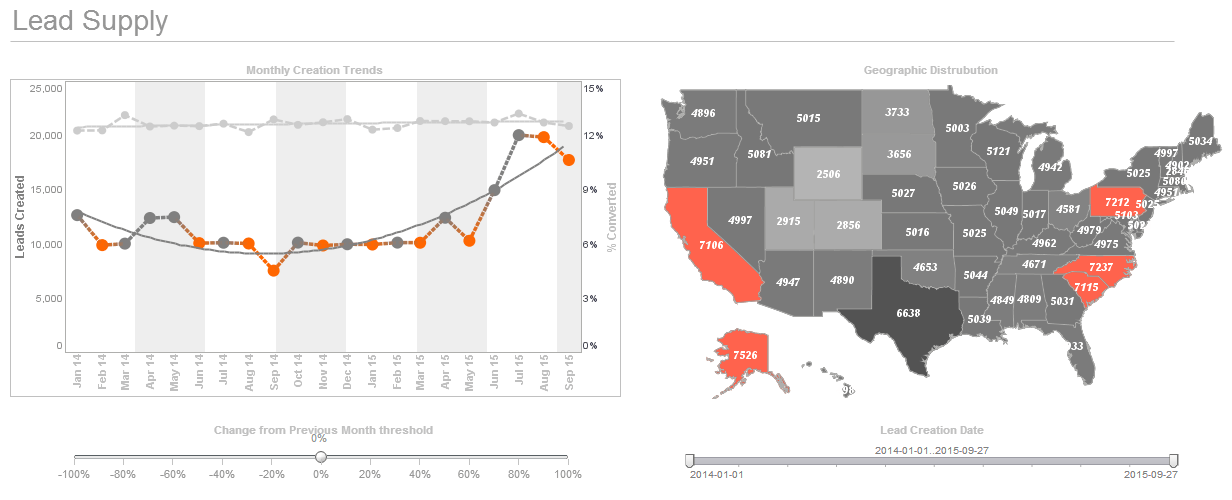Java-Based Dashboard Software That is Flexibly Deployed and Easy to Use
InetSoft's dashboard software is 100% Java code at the server level and JavaScript and HTML5 at the browser client level, and native mobile apps.
Combined with its SOA architecture and open standards-based technology, the application makes for an ideal embedding and integration-ready tool for dashboards, scorecards, and reporting in jsp pages.
End-users get visually compelling, highly interactive access to data, and solution providers get a highly customizable, quick to learn and quick to deploy dashboard tools, templates, and information delivery platform.
InetSoft's executive dashboard application is jsr 168 compliant so it can be embedded as a portlet in an internal information portal or an external Web-based solution.
What Are the Advantages of Dashboard Software Being Java-Based?
Java remains one of the most versatile and time-tested programming languages in enterprise software, and its benefits extend deeply into the domain of dashboard and data visualization tools. When dashboard software is built using Java, it unlocks a suite of performance, security, and interoperability advantages that align perfectly with the needs of modern organizations—especially those operating in distributed, heterogeneous environments.
1. Cross-Platform Compatibility
One of the foundational benefits of Java is its “write once, run anywhere” capability. Java dashboard software can operate seamlessly across multiple platforms—Windows, macOS, Linux, and others—without requiring code changes. This is critical for organizations that deploy dashboards across various teams, devices, and operating systems.
- Ensures uniform dashboard behavior across environments
- Reduces the overhead of maintaining multiple builds
- Ideal for field teams with mobile clients or BYOD policies
2. JVM Performance and Scalability
Java Virtual Machine (JVM) brings optimized performance and garbage collection, making Java-based dashboards highly scalable. For large enterprises managing dozens of concurrent users and massive datasets, this performance model ensures responsive interactions and minimal latency.
- Supports high-throughput scenarios
- Efficient memory management helps with handling large data visualizations
- Concurrency features allow real-time collaboration and live updates
3. Rich Ecosystem of Libraries and Frameworks
Java developers benefit from a mature ecosystem of open-source and proprietary libraries for data processing, charting, UI components, and security. This allows dashboard software vendors to build highly functional, modular tools rapidly.
- Apache POI: integration for Excel exports
- JFreeChart / XChart: custom chart rendering
- Spring Boot: embedding dashboards in microservices
- Vaadin / JavaFX: for sophisticated UI layouts
4. Strong Integration Capabilities
Java’s deep integration support means dashboard platforms can connect to enterprise data sources like JDBC-compliant databases, web services, message queues, and ERP systems. With built-in connectors and RESTful services, dashboard software becomes a nexus of real-time decision-making.
- Supports data integrations with Oracle, MySQL, SQL Server, and more
- Can pull and push data to other Java-based applications seamlessly
- Enables streaming analytics from Kafka, MQTT, and IoT pipelines
5. Security at Scale
Security is paramount for business intelligence tools, and Java's mature access control mechanisms make it a safe choice. Java dashboard platforms often incorporate:
- Role-based access controls (RBAC) and LDAP integration
- Secure communication via HTTPS, TLS, and OAuth 2.0
- Java Security Manager and custom permissions for sandboxing
- Input validation and protection against SQL injection, XSS, etc.
6. Modular and Maintainable Codebase
Java encourages modular programming practices using packages, interfaces, and class abstractions. This leads to well-organized dashboard software that's easier to maintain and extend over time. Features like MVC (Model-View-Controller) or layered architecture mean developers can update UI or business logic independently.
- Simplifies customizations for industry-specific dashboard needs
- Facilitates third-party plugin integration and API extensions
- Improves testing and debugging workflow
7. Vendor Independence and Open Standards
Java is governed by open standards (through the Java Community Process), which gives developers and enterprises confidence in long-term support and stability. Java-based dashboards are less likely to be locked into proprietary ecosystems.
- Can be deployed on-premises, hybrid cloud, or full cloud environments
- Works with a variety of UI toolkits, containers, and application servers
- Allows organizations to retain control over data and infrastructure
8. Real-Time Analytics and Thread Management
Java’s built-in multithreading model allows dashboards to handle simultaneous data queries, user interactions, and background updates without freezing. This makes Java dashboard software especially adept at delivering real-time analytics.
- Live updates for financial dashboards, manufacturing sensors, logistics feeds
- Non-blocking design improves responsiveness even under load
- Can support interactive features like hover tooltips, drilldowns, and animations
9. Long-Term Viability and Developer Talent Pool
With millions of developers trained in Java worldwide, businesses that adopt Java-based dashboard platforms enjoy a deep talent pool for customization, maintenance, and innovation. Whether in-house development or vendor support, the availability of expertise ensures continuity.
- Reduces onboarding costs and training times
- Supports rapid prototyping of new dashboard features
- Encourages community engagement and third-party contributions

